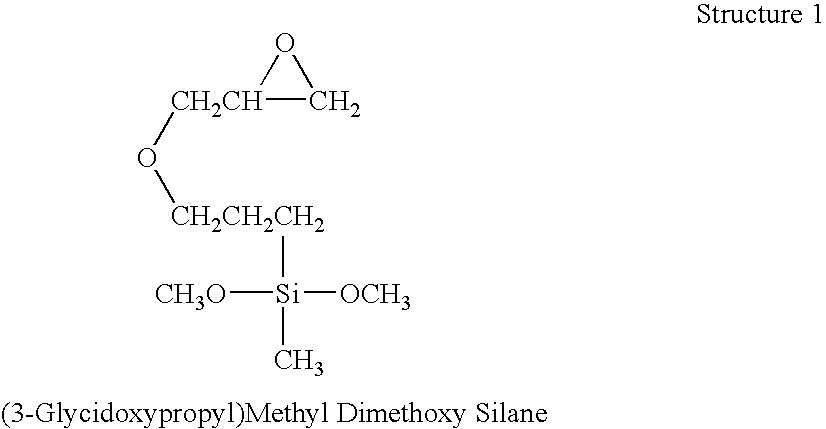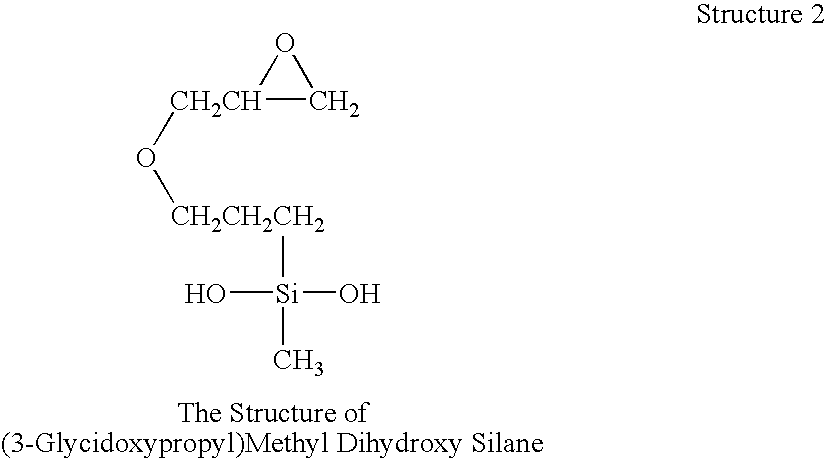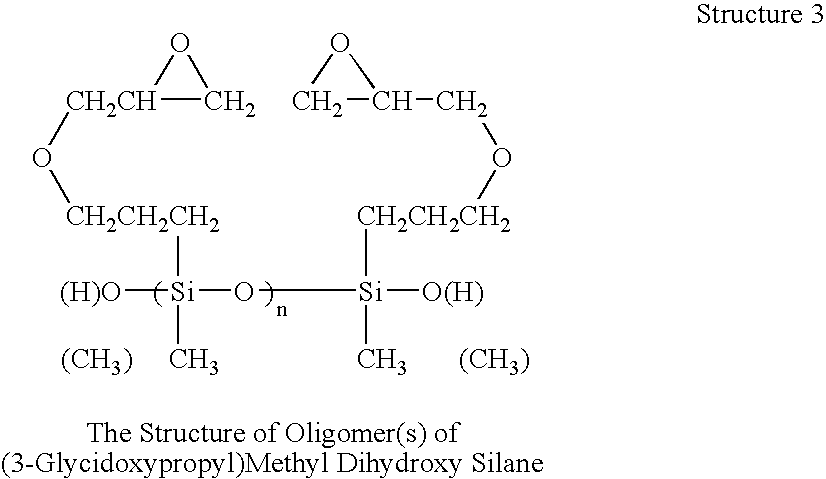Spd light valves incorporating films comprising improved matrix polymers and methods for making such matrix polymers
a technology of matrix polymer and light valve, which is applied in the direction of electric/magnetic/electromagnetic heating, instruments, static indicating devices, etc., can solve the problems of destroying the appearance and proper functioning affecting the production efficiency affecting the quality of the spd film, etc., to facilitate the shipment of substantial quantities of manufactured spd film.
- Summary
- Abstract
- Description
- Claims
- Application Information
AI Technical Summary
Benefits of technology
Problems solved by technology
Method used
Image
Examples
example 1
Prior Art
Synthesis of Matrix Siloxane Copolymer of 1.4717
[0032]Into a 1 L reaction kettle was weighed 90 g of (previously distilled and purified) disilanol terminated dimethyl (82-86%) diphenyl (14-18%) siloxane copolymer (sometimes herein referred to as “copodisilanol”), 10 g of 3-acryloxypropylmethyl dimethoxy silane and 400 mL of heptane. The reaction kettle was fitted with two Dean-Stark (“D-S”) traps and through the third port a mechanical agitation device was introduced. The fourth port on the kettle lid was covered with a septum for drawing out aliquots for monitoring the progress of the reaction. The contents of the reaction kettle were brought to reflux and allowed to reflux for 90 minutes without catalyst addition. Some condensation took place, as evidenced by the collection of water in the D-S traps. The catalyst, i.e., tin(II) 2-ethylhexanoate, (0.03 g) in 10 mL of heptane, was introduced through a syringe into the kettle through the septum. Condensation...
example 2
Synthesis of Siloxane Matrix Copolymer
According to the Invention Having Relatively Strong Adhesion to Substrates
[0038]Into a 500 ml, 3-neck round bottom flask was weighted 45 g of (previously distilled and purified) disilanol-terminated dimethyl (82-86%) diphenyl (14-18%) siloxane copolymer (sometimes herein referred to as “copodisilanol”), 5 g of 3-acryloxypropylmethyl dimethoxy silane (the “cross-linkable monomer”), 1 g of (3-glycidoxy propyl)methyl dimethoxysilane, (the “new monomer”), and 200 ml of heptane. The flask was fitted with a Dean-Stark (“D-S”) trap and through the second port a mechanical agitation device was introduced. The third port on the flask was covered with a septum for drawing out aliquots for monitoring the progress of the reaction. The contents of the reaction flask were brought to reflux and allowed to reflux for 30 minutes without catalyst addition. Some condensation took place, as evidenced by the collection of water in the D-S trap. The catalyst, i.e., t...
example 3
Alternative Method of Synthesizing a Siloxane Matrix Copolymer According to the Invention Having Relatively Strong Adhesion to Substrates and Comprising a Larger Amount of the New Monomer Than That Used in Example 2
[0042]Into a 500 ml, 3-neck round bottom flask was weighted 45 g of (previously distilled and purified) disilanol-terminated dimethyl (82-86%) diphenyl (14-18%) siloxane copolymer (sometimes herein referred to as “copodisilanol”), 5 g of 3-acryloxypropylmethyl dimethoxy silane (the “cross-linkable monomer”) and 180 ml of heptane. The flask was fitted with a Dean-Stark (“D-S”) trap and through the second port a mechanical agitation device was introduced. The third port on the flask was covered with a septum for drawing out aliquots for monitoring the progress of the reaction. The contents of the reaction flask were brought to reflux and allowed to reflux for 30 minutes without catalyst addition. Some condensation took place, as evidenced by the collection of water in the ...
PUM
| Property | Measurement | Unit |
|---|---|---|
| thickness | aaaaa | aaaaa |
| thickness | aaaaa | aaaaa |
| wavelength | aaaaa | aaaaa |
Abstract
Description
Claims
Application Information
 Login to View More
Login to View More - R&D
- Intellectual Property
- Life Sciences
- Materials
- Tech Scout
- Unparalleled Data Quality
- Higher Quality Content
- 60% Fewer Hallucinations
Browse by: Latest US Patents, China's latest patents, Technical Efficacy Thesaurus, Application Domain, Technology Topic, Popular Technical Reports.
© 2025 PatSnap. All rights reserved.Legal|Privacy policy|Modern Slavery Act Transparency Statement|Sitemap|About US| Contact US: help@patsnap.com



